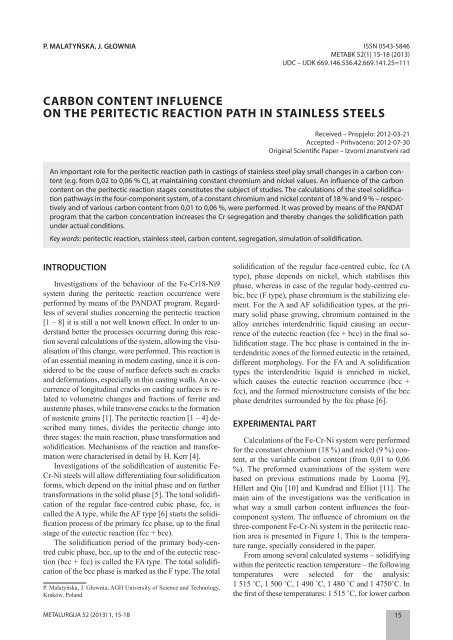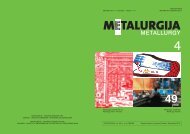Metalurgija: sadašnjost Metallurgy: Present Metalurgija ... - CARNet
Metalurgija: sadašnjost Metallurgy: Present Metalurgija ... - CARNet
Metalurgija: sadašnjost Metallurgy: Present Metalurgija ... - CARNet
You also want an ePaper? Increase the reach of your titles
YUMPU automatically turns print PDFs into web optimized ePapers that Google loves.
P. MALATYŃSKA, J. GŁOWNIA<br />
CARBON CONTENT INFLUENCE<br />
ON THE PERITECTIC REACTION PATH IN STAINLESS STEELS<br />
P. Malatyńska, J. Głownia, AGH University of Science and Technology,<br />
Kraków, Poland<br />
METALURGIJA 52 (2013) 1, 15-18<br />
ISSN 0543-5846<br />
METABK 52(1) 15-18 (2013)<br />
UDC – UDK 669.146.536.42.669.141.25=111<br />
Received – Prispjelo: 2012-03-21<br />
Accepted – Prihvaćeno: 2012-07-30<br />
Original Scientifi c Paper – Izvorni znanstveni rad<br />
An important role for the peritectic reaction path in castings of stainless steel play small changes in a carbon content<br />
(e.g. from 0,02 to 0,06 % C), at maintaining constant chromium and nickel values. An infl uence of the carbon<br />
content on the peritectic reaction stages constitutes the subject of studies. The calculations of the steel solidifi cation<br />
pathways in the four-component system, of a constant chromium and nickel content of 18 % and 9 % – respectively<br />
and of various carbon content from 0,01 to 0,06 %, were performed. It was proved by means of the PANDAT<br />
program that the carbon concentration increases the Cr segregation and thereby changes the solidifi cation path<br />
under actual conditions.<br />
Key words: peritectic reaction, stainless steel, carbon content, segregation, simulation of solidifi cation.<br />
INTRODUCTION<br />
Investigations of the behaviour of the Fe-Cr18-Ni9<br />
system during the peritectic reaction occurrence were<br />
performed by means of the PANDAT program. Regardless<br />
of several studies concerning the peritectic reaction<br />
[1 – 8] it is still a not well known effect. In order to understand<br />
better the processes occurring during this reaction<br />
several calculations of the system, allowing the visualisation<br />
of this change, were performed. This reaction is<br />
of an essential meaning in modern casting, since it is considered<br />
to be the cause of surface defects such as cracks<br />
and deformations, especially in thin casting walls. An occurrence<br />
of longitudinal cracks on casting surfaces is related<br />
to volumetric changes and fractions of ferrite and<br />
austenite phases, while transverse cracks to the formation<br />
of austenite grains [1]. The peritectic reaction [1 – 4] described<br />
many times, divides the peritectic change into<br />
three stages: the main reaction, phase transformation and<br />
solidifi cation. Mechanisms of the reaction and transformation<br />
were characterised in detail by H. Kerr [4].<br />
Investigations of the solidifi cation of austenitic Fe-<br />
Cr-Ni steels will allow differentiating four solidifi cation<br />
forms, which depend on the initial phase and on further<br />
transformations in the solid phase [5]. The total solidifi -<br />
cation of the regular face-centred cubic phase, fcc, is<br />
called the A type, while the AF type [6] starts the solidifi<br />
cation process of the primary fcc phase, up to the fi nal<br />
stage of the eutectic reaction (fcc + bcc).<br />
The solidifi cation period of the primary body-centred<br />
cubic phase, bcc, up to the end of the eutectic reaction<br />
(bcc + fcc) is called the FA type. The total solidifi -<br />
cation of the bcc phase is marked as the F type. The total<br />
solidifi cation of the regular face-centred cubic, fcc (A<br />
type), phase depends on nickel, which stabilises this<br />
phase, whereas in case of the regular body-centred cubic,<br />
bcc (F type), phase chromium is the stabilizing element.<br />
For the A and AF solidifi cation types, at the primary<br />
solid phase growing, chromium contained in the<br />
alloy enriches interdendritic liquid causing an occurrence<br />
of the eutectic reaction (fcc + bcc) in the fi nal solidifi<br />
cation stage. The bcc phase is contained in the interdendritic<br />
zones of the formed eutectic in the retained,<br />
different morphology. For the FA and A solidifi cation<br />
types the interdendritic liquid is enriched in nickel,<br />
which causes the eutectic reaction occurrence (bcc +<br />
fcc), and the formed microstructure consists of the bcc<br />
phase dendrites surrounded by the fcc phase [6].<br />
EXPERIMENTAL PART<br />
Calculations of the Fe-Cr-Ni system were performed<br />
for the constant chromium (18 %) and nickel (9 %) content,<br />
at the variable carbon content (from 0,01 to 0,06<br />
%). The preformed examinations of the system were<br />
based on previous estimations made by Luoma [9],<br />
Hillert and Qiu [10] and Kundrad and Elliot [11]. The<br />
main aim of the investigations was the verifi cation in<br />
what way a small carbon content infl uences the fourcomponent<br />
system. The infl uence of chromium on the<br />
three-component Fe-Cr-Ni system in the peritectic reaction<br />
area is presented in Figure 1. This is the temperature<br />
range, specially considered in the paper.<br />
From among several calculated systems – solidifying<br />
within the peritectic reaction temperature – the following<br />
temperatures were selected for the analysis:<br />
1 515 ˚C, 1 500 ˚C, 1 490 ˚C, 1 480 ˚C and 1 4750˚C. In<br />
the fi rst of these temperatures: 1 515 ˚C, for lower carbon<br />
15
















